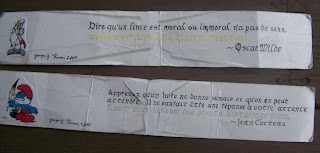One thing I did change, however, were the bookmarks the kids were using. These bookmarks were big, because their job was to hold the place of a book on the shelves, while the kids looked at them, and decided whether they wanted to borrow that particular book. And since these were elementary schools, some of the books were big, and so the bookmarks were just as oversized. They were over a foot long, and about an inch-and-a-half, two inches wide. But they were beaten up. Boy, were they beaten up. They were torn, creased, folded in two, and in some cases, as the lamination split apart, so did the paper. They also lacked something that said "This is the library!" One school's was simply numbered. Blank bookmarks, with a number on one end. And believe it or not, the kids actually found numbers to fight over. Seriously. You would have a kid whining "I wanted 34!", and another kid gloating that they were the best, because *they* got 34. At the other school, it had been one of the classes that had drawn them, with the resulting variability in designs... The boys didn't want the bookmarks that had rainbows and flowers, and the girls didn't want the ones that had guns and explosions (Really. At least one bookmark (I remember one clearly) had a number of small guns drawn with markers, along with starbursts explosions). These had been drawn by those that were then in grade 8, when they had been in grade 3. So they'd had five years of abuse, by at least four classes a year.
So I'd decided that I'd leave my mark in a way that was unobtrusive, but still unavoidable--I'd make both schools new bookmarks.

The idea was simple enough. Make bookmarks that clearly say "this is the library". Each bookmark was to have a quote written on it, on the topic of books, reading, writing, or the library. The quotes were mainly from francophone, primarily French, authors, although there were some German, Dutch, and English authors thrown in. As well as Groucho Marx. Due to the size of the classes, I had to make a large number of bookmarks (Thirty-four), which meant that I had to make 68 bookmarks (one set for each school), and find 68 quotes (two for each bookmark, one on each side), as well as images of 34 literary characters. The quotes couldn't be too long, should be understandable (or at least, I should be able to explain them), and the characters had to be from books that were contained in the library (and preferably by francophone authors).
It took me about two months to write up all the bookmarks, which was not too shabby, since it was tiring, and since this was my first project of this size, I had to deal with complications as they appeared. I had a number of different scripts to pick from, and I used as many as I could, and used a number of different ink colours as well. And mistakes were not uncommon. These I dealt with in the medieval manner: scrape off the ink, and keep going! Nice thing is, since I was using cardstock, these mistakes were sometimes difficult to find.

Finally, around mid-April 2008, I'd finished 68 bookmarks, split them up so each school got a set, and brought them in. I'd spoken about them for so long, and the kids had been asking when the new bookmarks would be in for so long, I decided to have a bit of fun with the "reveal"... The grade 3-4 class came in, sat down, and... waited. I started playing Carl Orff's "O Fortuna", because, really, isn't just the most dramatic choral and orchestral piece around? As the piece started, I picked up a wastebasket, then picked up and tossed in the old bookmarks. When the first "climax" hit (about 15 seconds into the tune), I triumphantly raised up the new bookmarks. The class started cheering, applauding... They were so enthusiastic, a teacher's aide came from the other side of the school scolding as to what all the noise was, since we could be heard on the other side.
I handed out the bookmarks, they marvelled at them, and within 15 seconds, they were being folded.
Oddly enough, the kids didn't believe me when I told them they were all hand-written. It would seem I did such a good job (and, well, who does calligraphy these days?), that they couldn't wrap their heads around it, until I would randomly write the name of one of the kids in various styles, that they would realize "well, geez, he really can write like that!"
They've survived four years of rough usage by the kids, and they'll hopefully be replaced next year, before they fall apart...

And they're very popular. I'm down to 28 at one school, and I have no idea how many still remain at the other school.






